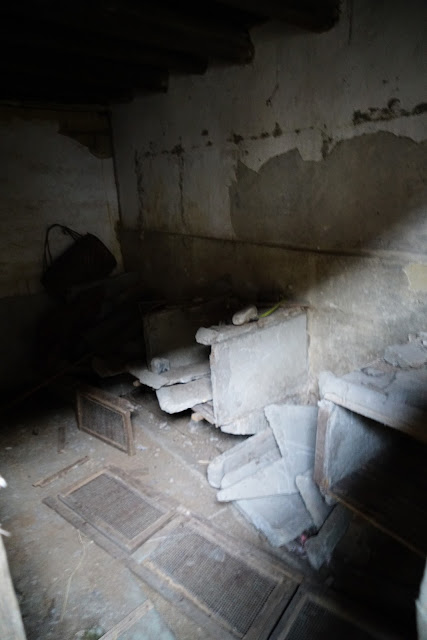When one visits China nowadays, one just can't help being struck by the
pace of change. Brand new tall buildings with aluminium window frames
sitting on a huge commercial podium with shiny plexiglass window panes and revolving
door stand just a few meters away from old dilapidated one story brick houses
with tiled roofs and grass or some other small plants growing in the
crevices of the tiles where a little earth has collected with a little patch of loam right in
front of the house where a few rows of vegetables are growing and a few
chickens are running around their heads jerkily bobbing up and down pecking away at what they think of as edible worms or insects.

A new town our coach passes through after lunch
River with unruffled surface on the outskirt of that town called Heyuan ( 河源市)
Our destination, the Teapot Handle Court (茶壺耳圍屋) of New Tea Village of Oily Creek in the Lin Ping County of Heyuan City, (河源市連平縣油溪镇茶新村) in northeast Quangdong, more popularly known as "茶壺耳屋" (Teapot Handle House).
Apparently, several tens of kilos of firecrackers had been lit in the morning to greet the year of the monkey.
There's a huge D--shaped pond in front of the group of houses from which it got its name.
It was close to sunset
We can still catch a few of its dying rays
The picture of serenity
The pond from the side
A front view of the group of houses.
The owner of the house was extremely accomodating. She allowed us to mount her roof top so that we might get a better view of the shape of the famous pond.
The dying rays. Not a soul in sight.
The very unusual shape of the front wall with white and blue floral decoration underneath
Inside we could rows of contiguous apartments, a characteristic of Hakka style of enclosed houses (圍屋).
The window with strong lattices and wooden door have probably been there some 200 years ago when it was first built by the 17th generation of the Wong clan headed by 黃錫銅. One could see the cobbled alleys.

pieces of the old cabinet doors lying on the ground
The spout of an old pump using underground water
There are narrow passageways between the different rows of houses
New planks ready for use for repairs.
Part of the plaster had peeled off exposing the yellow mud brick below
The pedestrian paths on both sides are shielded by overhanging eaves.
Another alley
Peasant-type reed baskets for carrying vegetable and other stuffs
Plenty of new planks are lying about. Some sort of renovation must have been planned in the next few months.
Metal mesh shield to stop mosquitos from entering
Wall painting crafted by dehydrated mosses.
rows and rows of glazed urns for seasoning vegetable that could not be eaten or for making wine
storerooms
The wooden support for or threshing/winnowing machines?
The threshing machine lying against the wall
The surrounding fields
Red lanterns of two of the families of the Wong clan
They really look like a mini fort
Window with rusted metal mesh
Strong ventilation window for creating draught
Another one, shaped like a key hole.
The women appear to favor colorful traditional style baby-carryng cloth basinets
This group of houses was once the local underground Communist Party headquarters
The roof tiles still seem quite new.
It seems that not everyone has relocated into more contemporary housing elsewhere.

This tong must have very faithful issues as the ancestral tablet seems well maintained/
rows of red lanterns
a puzzled boy in new clothes
lanterns everywhere
firewood
All kinds of old planks
balustraded windows
freshly chopped firewoood ready for use at the exterior wall
Lanterns of the Kong Ha Tong
Must be the biggest family within the clan
ashes from used joss sticks with scraps from a few fire crackers
it's getting darker
Time for lights
A last look: really dark now. We were told to return for the dragon and lion dance the next morning, an event which has not been staged for about a decade. According to a memorial plague at the house, it took three generations of Wongs to build this group of houses and explained that the Wong clan here first started out as 3 coolies working for a Fujian patron who died on one of the trading trips. But despite his death, the three Wong brothers faithfully delivered the goods to their destination and returned their boss' body to his family. Out of gratitude, they were given a few shops and then started the business a grocery and general provision store. After some 20 odd years, they amassed enough money to build the first house when they were in their late 40s' and eventually completed it with some 180 houses in the group with three main ancestral halls, one for each branch of the Wong family. They hrabored the belief that the more cobble stones they placed on each path or alley, the more children they would have. Their ancestors originally came from Hubei in the Han Dynasty. In 2010, the municipal authorities decided to spend 3 million RMB to renovate the group of houses as part of its effort to preserve the historical monuments in the area. At its height, more than 400 Wongs were living here but now, only one or two families are still there. How the times are changing. Yet, no matter how much they change, there always remains a little something which somehow can't be completely erased, the traces of that past, like footprints in the sand, or in this case, embedded in the old and worn cobble stones, ancestral tablets, the yellow mud bricks, dismembered broken wooden farm implements, the faded balustrades, the broken tiles, the tradition of lantern hanging during important festivals or ceremonial occasions and the memories of that distant and not so distant past.



















































沒有留言:
張貼留言